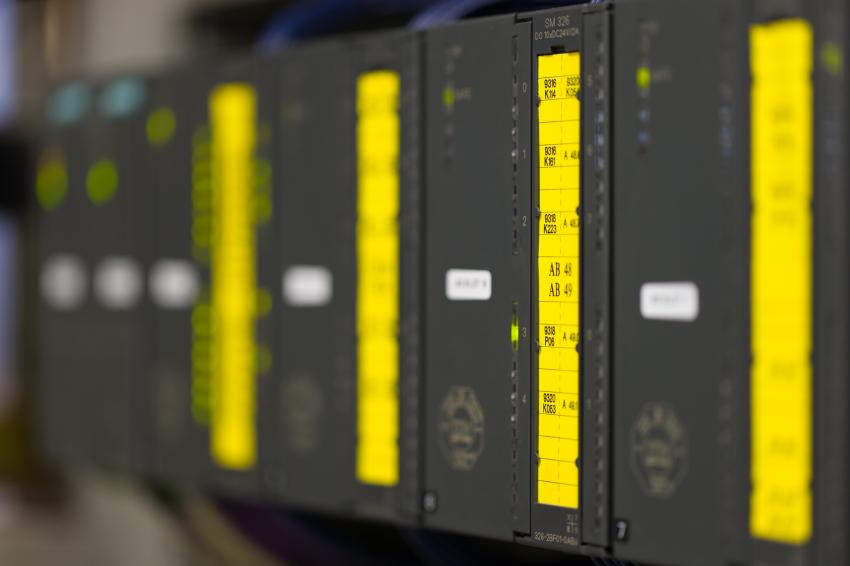One batch more
Migration of a process control system modernizes synthetic resin production and boosts productivity
17 days and not a day longer – this was the initial situation for the migration of a process control system of a large resin reactor. With the help of simulation, virtual test methods and standardized factory and site acceptance tests (FAT / SAT) the transition to a new automation world went without a hitch. And what's more, it was possible to increase the capacity by one resin batch per week.
The time frame was short and not the most favorable – between December 17 and January 3, an outdated control system (ABB Infi 90) had to be migrated to a Simatic PCS 7 system. To do this, the operating company wanted to take full advantage of a time window where reactor 5 at the Belgian Mechelen chemical facility was shut down. Initially, there was not much of a Christmas spirit, but all the participating parties were proud of the project after everything went to plan. “It’s a huge challenge, but also a great opportunity when something has to change –– like our reactor 5, our largest reactor here at the facility. It was about the middle of 2010 when we decided to migrate from an outdated ABB system to a very competitive Simatic PCS 7 process control system”, explained Geert Van Roy, Manufacturing Technology Lead, Axalta, enthusiastically looking back at the project.
Paints for trucks and cars
Axalta Coating Systems is one of the leading manufacturers of environmentally-friendly paints for truck and car suppliers. Well-known brands for repair coatings, which are used by many companies specializing in lacquer finish and vehicle body painting including Standox, Spies Hecker, Ixell, Permasolid and Cromax, for instance. The products are manufactured in batches according to customer order. Nowadays, customers can have very demanding requirements: paints that dry quickly, have a high opacity, a particular viscosity or are water-based. After they have been manufactured, the products are sent directly to shipping or warehoused in small quantities as special-purpose products. They are filled into various packaging units (cans, canisters, drums). More than 1000 products and containers are manufactured at the site. It is not surprising therefore, that flexibility is a key factor in the production process. This is the only way to guarantee high quality and the product characteristics required by consumers in production. Attention to detail is crucial from the very outset. “If there’s something to learn out of 145 years of experience in the coating business, it is that quality is something that starts in the tiny very details of the process”, so the experience of Van Roy. Safety and the protection of the plants and the residents are other key factors in the production landscape. “The people who live around us, our neighbors, really rely on us and not only for supplying them with a good coating of their car – they also rely on us for being able to live a safe life over here, to live a healthy life and be environmentally friendly“, remarks Luc van den Hemel, Plant Manager of Axalta.
The heart of the production process
Mechelen is the largest Axalta site in Belgium and one of 35 worldwide. The site was founded in 1958 and was part of DuPont Performance Coatings until 2013. The process control revamp review team especially focused on reactor 5, the largest reactor in Mechelen. The task was not only to upgrade the automation technology but to increase capacity by 12 percent, a clear stipulation from company executive management. Nine batches of synthetic resin are now to be produced every week instead of the previous eight thanks to the flexibility of online modifications.
Siemens was a familiar name at the facility and Simatic PCS 7 components had already been used for reactor 3 and the tank farm. The Axalta automation team opted for a PCS 7 V7.1 architecture with three clients (two in the control room and one client as explosion-protected HMI in the field), one engineering station and two redundant server pairs, connected in turn via Industrial Ethernet to two redundant 417-4 FH. Various Sitrans measuring instruments for pressure, temperature, flow rate and level were also used. “Process safety and flexibility both play a key role in our industry”, says Van Roy. “Simatic Batch offers us recipe-based batch control with extra flexibility and reproducibility that easily adds an edge to the efficiency of this production plant.”
The technology was not the only important factor in deciding in favor of Siemens, but also the confidence from former projects and the plan that the migration would be completed on schedule. The engineering started in February 2011 and was completed in July 2011. The training and the initial tests were also conducted in this period. The factory acceptance test (FAT) followed in November and December 2011, just prior to the most exciting phase of the project.
Standards speed up the work
The standard library of PCS 7, the Advanced Process Library (APL) was used for all DCS components in order to complete the project within the allotted period. Hardly any modifications were made to this library – in fact just a mere 3 percent. “For the migration here on site, we were only able to reserve a very short, 17 day shutdown period. The solution we thought would be to make things as standardized as possible – trying to build on the strong standard library of Simatic PCS 7”, explains Dirk Draelants, Resin Process Engineer, Axalta.
The basic process control system (BPCS) and the emergency shutdown system (ESD) also had to be integrated into PCS 7. “The Safety Matrix easily enables us to configure the safety applications during engineering. It’s also a great tool for the operators to follow online all the safety functions of the reactor in detail, even up to the level of the field devices”, Draelants says with enthusiasm. The cause & effect Simatic Safety Matrix not only means that programming of the safety logic is significantly simpler and more convenient, but also much faster than when applying a conventional approach. During the risk analysis of a plant, the plant planner can assign precisely defined reactions to events that may occur in a process.
The design of the graphical user interface (GUI) was a minor detail, but one that is crucial when it comes to handling the system on a daily basis. Its appearance was adapted to the visualization with the help of the Siemens color code system. This made the transition very easy for the plant operators.
FAT: the key to quick migration
All participating parties focused on the FAT in particular – it was clear to all that this is the key for a smooth transition later on. The dynamic in-house process simulation tool, developed in the USA, was used for this task. “A key is a very efficient FAT – which had to be done virtually using our own in-house process simulation and Simatic PCS 7 to control it. Simit, the simulation tool of Siemens, acted as a link between the two systems – and this resulted in a very high-quality FAT testing of the batch sequences”, says Draelants, describing the smooth and problem-free commissioning. Simit Simulation Framework, the Siemens process simulation tool, interfaced the PCS 7-system to the in-house simulation tool to supply very detailed data on the individual process field variables. This meant that the Siemens hardware test settings precisely corresponded with the process settings. Up to four people were able to use the simulation environment simultaneously. The I/Os, the batch sequences and the recipe settings were tested in considerable detail. This allowed function and programming errors to be quickly resolved. “We are very impressed about the engineering and commissioning quality with Simit and Safety Matrix. These tools saved us time and costs”, Draelants concludes.
Site Acceptance Test
As the FAT had gone so smoothly, the participating parties were tense but not nervous when the Christmas period approached. All tasks had been defined, such as disassembling the old system and installing the new hardware and software, testing the I/O components, performing the safety interlock test and setting the temperature and flow controllers. A "solvent run" as part of the cold and hot commissioning was then executed before the first commercial resin recipe was run. This first resin batch ran very smoothly and was a great success, on time and to specifications. “Building on thorough testing and simulation, it was not a surprise to me that the commissioning was done well in time and according to all the quality standards we had defined, but success didn’t stop here”, Van Roy summarizes the mood at the time.
Project outlook
The plant has been running smoothly since then, as van den Hemel reports: “Quality is a prerequisite, but it’s not the only thing that gives us business success. Flexibility really translates into quantity for us. As we were able to make eight batches before, now we are able to make nine batches a week with the Siemens solution. So that’s 12 percent difference, that’s a big step in our industry.” Only minor details of the automation solution have been changed since then. The visualization of the tank farm has, for instance, been integrated into PCS 7 and the batch report has been improved. For training purposes, a few small changes have also been made to the dynamic process simulator.
“We didn’t only look for the highest quality possible, we also looked at productivity and efficiency and flexibility of our batching systems. We met all targets for reactor 5, and we are certain that we will continue the success story together with Siemens in converting all of the other reactors”, van den Hemel says with conviction. Because this migration was so successful, plans are already underway to also modernize the control system for reactor 4 based on Siemens products and expertise.










